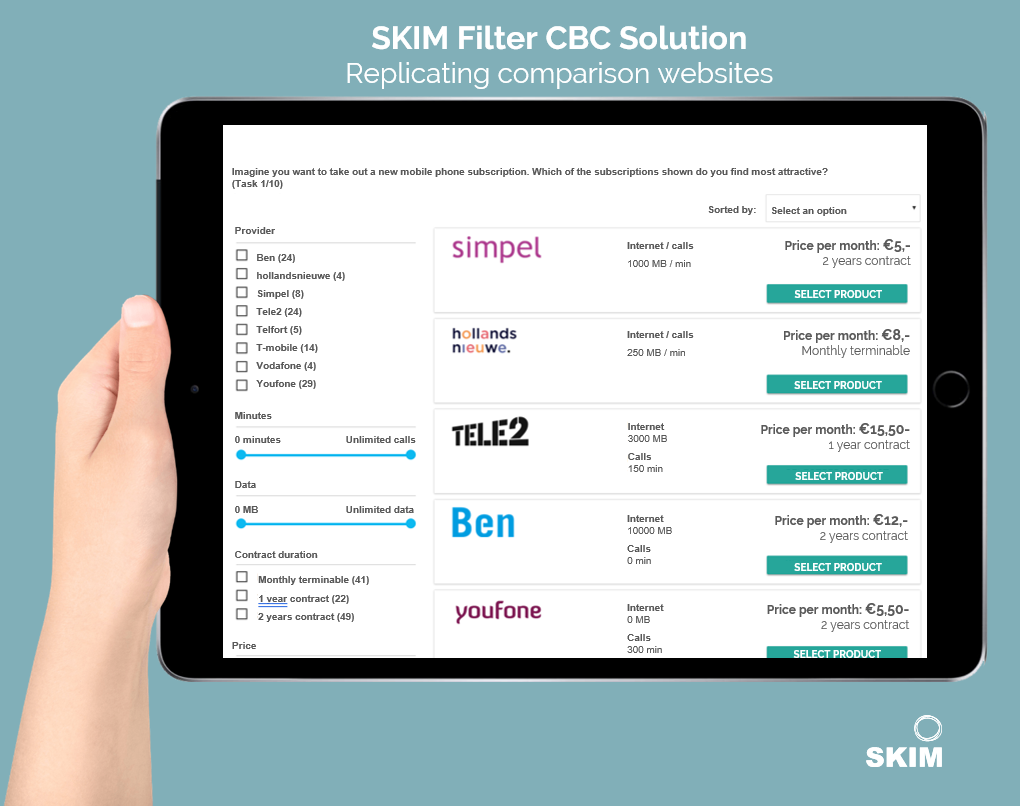Understanding decision-making and choice overload in crowded markets
In today’s highly competitive telecommunications market, consumers face an abundance of choices online. To thrive in this environment, your product portfolio strategy should be optimized based on how decision-making is changing. You need to know how customers identify the best carrier and plan for their needs. And that’s where the most accurate customer and market insights can help.
Marketers realize shopping decisions and price comparisons are often made online. However, understanding, and accurately predicting, exactly how shoppers find and choose products and services online has been difficult. Such was the challenge VodafoneZiggo recently tackled as it needed to differentiate itself in a maturing market.
While you may not be in the telecom market, you may face similar challenges of predicting online shopper behavior. For example, do you know which factors or filters (e.g. brand, price, etc.) are a priority when your customers search online?
Read on to learn how a new insights approach, which better predicts online consumer choice, is helping leading companies improve revenue and portfolio management.
Changing consumer decision-making in the mobile phone market
VodafoneZiggo, a leading telecommunications company in the Netherlands, offers two brands in the mobile market: Vodafone (premium) and hollandsnieuwe (no-frills). As consumer attitudes towards mobile phone plans evolve, the company needed to adjust its product portfolio strategy – especially to remain competitive in the no-frills market.
According to VodafoneZiggo’s Market and Consumer Insights Manager, Kris Compiet, its consumers consider data more important than minutes when selecting new subscription plans.
“You see that customers don’t take minutes into consideration. More and more, it’s all about data and two of our competitors also introduced unlimited data subscriptions,” Compiet said.
“As a no-frills brand we need to adjust our portfolio to this [change],” she added.
Hollandsnieuwe was differentiating its bundles based on units – a combination of voice, text and data. With the shifting consumer focus on data, it needed to reassess whether they should keep the current units structure, or move towards bundles with separate allowances for data and voice.
Uncovering behavioral data on price comparison websites
VodafoneZiggo’s insights manager came to SKIM with a common problem many marketers face when competing in a crowded and quickly evolving market:
She wanted to understand their customers’ decision behavior, particularly targeting the blind spots – the online channels they didn’t control.
Outside of their own website, the insights team at VodafoneZiggo doesn’t have easy access to behavioral data, especially on the popular price comparison websites.
With more consumer demand for data and “SIM-only” subscriptions, consumers are increasingly turning to these online sites to easily compare providers, bundles and prices. They filter and sort products to learn which offer best meets their specific requirements.
Understanding exactly how consumers use these filters would provide actionable insights for VodafoneZiggo’s portfolio strategy. And that’s where our team was able to dig in.
Innovating a new conjoint analysis approach for online shopping and search filters
When we partner with clients for portfolio optimization projects, we often recommend choice-based conjoint (CBC) analysis. This research technique provides rich insights into overall preferences and sensitivities of consumers. It allows us to test many attributes (e.g. brand, price, allowances, etc.) and simulate “what-if” scenarios to virtually predict the impact of changes to the portfolio.
As experts in choice modeling, we know first-hand that getting as close as possible to the correct context of the decision will yield the most accurate predictions. With today’s decision-making environment constantly changing, it’s more important than ever to accurately mimic the environment when surveying consumers. (It’s the reason we innovated our conjoint for mobile solution).
Traditional conjoint analysis provides the results of trade-off behavior between a high number of attributes, but lacks the realism of dozens of subscriptions to choose from at the same time.
To overcome these limitations for companies competing online, we developed the new Filter CBC Solution to replicate a price comparison website.

Filter CBC expands on traditional conjoint, analyzing consumers’ product choice reasoning, offering attribute variations (e.g. price, data etc.). However, it gets closer to reality for respondents by letting them see – and then filter – over 100 possible options. This research technique delivers more realistic results for more accurate insights.
Delivering online shopping insights to improve VodafoneZiggo’s product portfolio strategy
When VodafoneZiggo set out to optimize its Hollandsnieuwe product portfolio, the team needed deeper insights on how consumers behave online, especially on price comparison sites.
The SKIM Filter CBC solution did just that.
“With this new method we can estimate or predict consumer decision-making even better because it looks like the real world more than a conditional setting,” said Kris Compiet, Consumer and Market Insights Manager, VodafoneZiggo.
The research also produced some surprising results along the way around how consumers use filters including
- Data
- Minutes
- Brand
- Price
- Contract length

Consumers didn’t use price as a filter, they weren’t necessarily looking for the cheapest option. First, they searched for the perfect fit in terms of value (voice and data or units). Then they used price as a sorting tool, to find where they can get a good deal for the product that fits their needs.
In addition, Filter CBC brings us one step closer to reality. We realize there are some differences between how consumers behave in reality vs. how respondents behave in a survey. However, this approach yielded more realistic churn rates between brands and less extreme changes in preference share in various scenarios. We even saw higher respondent engagement.
Experts in predicting and influencing consumer choices
If you’re aiming to optimize your product portfolio or even online content like mobile hero images, it’s vital to understand the idiosyncrasies of different shopping environments. Certain features and behaviors are unique to the online world, e.g. filters, and are critical to replicate when trying to predict consumer decision-making.
Replicating the most realistic shopping context as accurately as possible will give you the most actionable consumer insights.

Partnering with insights experts who can innovate and blend the most appropriate research techniques can help you thrive in this constantly evolving marketplace.
With four decades of experience in researching, analyzing and understanding consumer insights, our team is eager to help you tackle your marketing blind spots.
Need to get a better understanding of how your consumers and their online activity in your market? 




